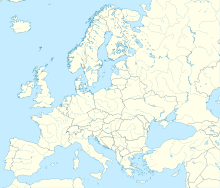Vaivara concentration camp
Vaivara concentration camp in Estonia
|
The Vaivara concentration camp was a National Socialist concentration camp in the Ida-Viru district in the small municipality of Vaivara , about 190 kilometers east of Tallinn , today's capital of Estonia .
founding
Estonia had been occupied by German troops since 1941. The Reichsfuhrer SS Heinrich Himmler ordered on 21 June 1943 to resolve the remaining ghettos in the Baltics. A large part of the Jews able to work should be used for oil shale production for the "Baltische Öl Gesellschaft mbH" ( Baltöl ), which is owned by the British New Consolidated Gold Fields Ltd. had taken over in Kohtla .
The Vaivara concentration camp was opened on September 19, 1943 as a reception and transit camp . The camp commandant was Hans Aumeier (most recently SS-Hauptsturmführer) for the entire duration of the Vaivara concentration camp . The administrative manager was Otto Brenneis . This concentration camp was temporarily subordinate to 27 subcamps, including the Klooga concentration camp . Several of these subcamps, known internally as “labor camps”, were the same size or even larger than the main camp Vaivara.
Prisoners
A total of 20,000 prisoners passed through the main camp. Most of them were transferred from the Ghetto Vilnius and Ghetto Kaunas camps, in many cases whole families. Smaller groups of German and Czech Jews were deported to Estonia via Theresienstadt ; Individual groups also arrived from Riga and Hungary. In November 1944, the maximum number of Jewish prisoners for the entire Vaivara camp system was determined to be 9,207.
Although the aim was to exploit the labor force but not to kill able-bodied Jews, one sixth of the camp inmates in the entire Vaivara camp complex died between October 1943 and June 1944 as a result of inadequate nutrition and eleven hours of hard work, poor hygiene and poor medical care. Children and those unable to work were grouped together in special camps in Vaivara (later in Ereda ). In February 1944, around 1,100 people unable to work, including 184 children, were sent to the Riga-Kaiserwald concentration camp or the Auschwitz concentration camp ; another group of 500 Jews was deported from Ereda in April 1944.
Subcamp / labor camp
In October 1943, eleven satellite camps were administered from Vaivara, later there were 21. In some cases, further production sites of the "Baltöl" and the Organization Todt (OT) are known from the files , in which Jewish forced laborers were used, but without this at this location a sub-camp of Vaivara can be proven. The forced laborers deployed there may have had to walk several hours a day.
The Vaivara concentration camps are named as follows: Aseri , Auvere , Erides , Kohtla-Goldfields , Jewe , Kerestowo , Kiviõli , Klooga , Kunda , Kuremaa , Lagedi , Lodensee , Narwa-Hungerburg , Narwa , Putki , Reval , Sonda , Soski , Ülenurme and Wiwikond .
Some of these camps were not used for oil shale extraction . Concrete-coated sea mines were built in Klooga , prisoners in the Narva camp built fortifications, and forced laborers in some small camps carried out track construction and forest work.
At Baltöl and the OT oil shale extraction operations, however, Jewish forced laborers only made up less than 20 percent of the workforce. The bulk of the workers were Soviet prisoners of war , resettlers from Russia, and forced and civil workers from a number of other countries, including France and Holland. These non-Jewish workers were housed in separate camps, often in the same place.
Warehouse liquidation
Most of the prisoners in the Vaivara concentration camp were evacuated on February 4, 1944, as the Red Army approached at the beginning of the month-long battle for the Narva bridgehead . The walk to Kohtla-Goldfields took three days; 44 people died on this death march . Before the subcamps were evacuated, around ten percent of the prisoners were shot after a selection in July 1944. Some of the prisoners were later loaded onto ships and taken to the Stutthof concentration camp and on to Natzweiler .
The prisoners who remained in Vaivara were liberated by the Red Army on June 28, 1944. The forced laborers in the Lagedi and Klooga camps were murdered in September 1944 by firing squads of the Waffen SS and the security police.
Commemoration
Concentration camps like Klooga and Ereda became places in the post-war period, in which the victims were commemorated and the liberation by Soviet troops was also celebrated. There was a controversy over this in independent Estonia. On the initiative of an American organization, memorial stones were placed exclusively for Jewish victims; the previously excessive figures were also corrected.
literature
- Ruth Bettina Birn: Viavara main camp / satellite camp. In: Wolfgang Benz , Barbara Distel (eds.): The place of terror . History of the National Socialist Concentration Camps. Volume 8: Riga, Warsaw, Vaivara, Kaunas, Płaszów, Kulmhof / Chełmno, Bełżec, Sobibór, Treblinka. CH Beck, Munich 2008, ISBN 978-3-406-57237-1 , pp. 131-183.
Web links
- Jewish Virtual Library (English)
Individual evidence
- ↑ "On the status of previous development and expansion work at the Baltic Oil GmbH" reported Albert Oeckl on January 17, 1944 to the Nazi economist and Europe-wide strategist Gustav Schlotterer , in: Albert Oeckl's life and professional activity until 1945 VS Verlag 2006 , ISBN 9783531149899 , doi : 10.1007 / 978-3-531-90199-2_3 .
- ↑ Ruth Bettina Birn: Viavara - main camp. Wolfgang Benz, Barbara Distel (ed.): The place of terror. History of the National Socialist Concentration Camps . Vol. 8, Munich 2008, ISBN 978-3-406-57237-1 , p. 132.
- ↑ Ruth Bettina Birn : Viavara - main camp. P. 134.
- ↑ Sixth ordinance for the implementation of the Federal Compensation Act (6th DV-BEG) . Retrieved February 22, 2018.
Coordinates: 59 ° 22 ′ 7.6 ″ N , 27 ° 45 ′ 41.4 ″ E

